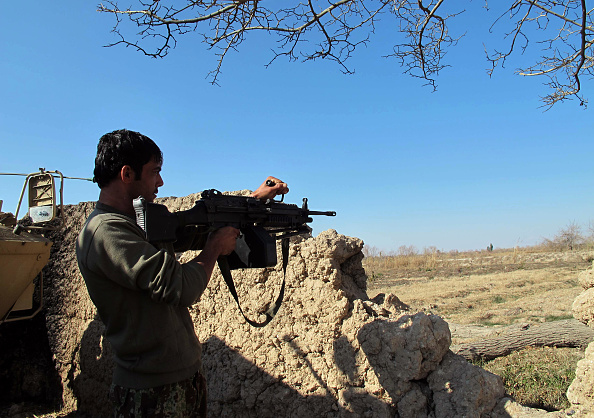
Just as the war against ISIS in Iraq seems to be getting better, the war against the Taliban in Afghanistan appears to be getting worse. Get used to it. While the enemies may have different names, they are both fueled by an Islamist fervor that suggests a long-term struggle, not unlike the Thirty Years’ War that ravaged Europe in the 17th Century. That bodes poorly for wrapping up this conflict—think of both wars as flip sides of the same coin—any time soon, absent a major and prolonged foreign intervention that seems unlikely.
Iraqi forces continued to claw their way back into Ramadi, the capital of Anbar province that has been in ISIS hands since May. “The fall of Ramadi is inevitable,” Army Colonel Steve Warren told reporters Tuesday from Baghdad. “The end is coming.”
While ISIS seeks to export its terror, the Taliban has confined its fighting to its home—although that home did become a haven for the al Qaeda terrorists who launched the 9/11 attacks. It is becoming increasingly clear that President Obama’s desire to bring U.S. troops home from the post-9/11 Middle East wars is a dream he’ll never achieve. “I do not support the idea of endless war,” he said two months ago, amid decisions to prolong the U.S. role in both Afghanistan and Iraq. How long a limited U.S. presence in the region is needed—to deny jihadists a staging area to launch attacks against the U.S.—is unknown.
Read More: Reading Between the Lines of Obama’s ISIS Pentagon Briefing
Yet even as Iraqi forces fight their way into Ramadi, U.S. military leaders, and six American families, are mourning the deaths of six U.S. troops at the hands of the Taliban in Afghanistan—a group the U.S. pushed out of power 14 years ago this month.
“Taliban rule is finished,” soon-to-be-Afghan-president Hamid Karzai declared December 7, 2001, exactly two months after the U.S. attacked Afghanistan for sheltering Osama bin Laden while the organization he headed plotted the attacks on New York and Washington. “As of today they are no longer a part of Afghanistan.”
While Karzai and bin Laden have been removed from power—and Obama soon will be—the Taliban are back. “Over the past year, together we have made gains that will put Afghanistan on a better path,” Defense Secretary Ashton Carter said last week during a visit to Afghanistan. “The Taliban’s advances in some parts of the country, even if only temporary, underscore that this is a tough fight, and it’s far from over.”
Even if only temporary? When the defense chief deploys caveats like that, troops under his command take notice. Shortly before Carter arrived in Afghanistan, the Pentagon issued a congressionally-mandated biannual report warning that security in Afghanistan has “deteriorated” in the second half of 2015. The worsening situation has slowed Obama’s pullout of U.S. troops. The 9,800 currently there will shrink to 5,500 by January 2017, when Obama leaves the Oval Office. “Insurgents are improving in their ability to find and exploit [Afghan] vulnerabilities, making the security situation still fragile in key areas and at risk of deterioration in other places,” the Pentagon report said.
Read More: Republicans Reveal Discord in Debate Over Dictators
On Tuesday, the Taliban were battling Afghan forces, advised by U.S. and British special-ops troops, for Sangin, a strategically important town in southern Afghanistan’s Helmand province. About 500 U.S. and British troops were killed pushing the Taliban out of the province between 2006 and 2010. The deputy governor of the province appealed—in a Facebook posting—to Afghan President Ashraf Ghani for military aid to prevent the Taliban from retaking control of the province.
The turmoil now sweeping the region are largely fueled by the religious hatred that has existed for 1,400 years between the Shia and Sunni branches of Islamic. Toppling regional dictators, who through brute force kept a lid on Islamic strife, has unleashed forces that, like the tides, can be tamed but never eliminated so long as that schism exists.
This is the growing face of war: ever since the lopsided U.S. victory over Saddam Hussein’s Iraq in 1991, nations have tried to steer clear, at least overtly, of conventional war with the U.S. That’s because conventional wars best suit the U.S. way of war. When the enemy is another state, combat can lead to compromise that can end the fighting. Both sides generally try to adhere to the Geneva Conventions, which set down rules of war for civilized states. Even when the war in Vietnam was morphing into a guerrilla conflict led by the Viet Cong, the fight was rooted in Vietnamese nationalism, which helped guide the fight down paths Washington knew.
But today’s fight against a virulent form of Islam—where martyrdom is prized—doesn’t offer such off-ramps. There’s a growing sense in the Pentagon and elsewhere that the unrest triggered by the 2011 Arab Spring could lead to something like that Thirty Years’ War, a conflict that began in between Catholic and Protestant states in Europe in 1618 that turned into one of the continent’s bloodiest eras.
For obvious reasons, the U.S. played no role in the original Thirty Years’ War. And while it played a role in triggering what might become the second, the U.S. needs to think long and hard before jumping into it any more deeply.
Read Next: U.S. Bombing of ISIS Oil Facilities Showing Progress
More Must-Reads from TIME
- Donald Trump Is TIME's 2024 Person of the Year
- Why We Chose Trump as Person of the Year
- Is Intermittent Fasting Good or Bad for You?
- The 100 Must-Read Books of 2024
- The 20 Best Christmas TV Episodes
- Column: If Optimism Feels Ridiculous Now, Try Hope
- The Future of Climate Action Is Trade Policy
- Merle Bombardieri Is Helping People Make the Baby Decision
Contact us at letters@time.com